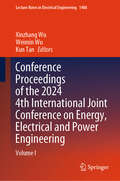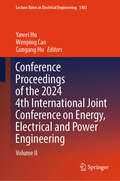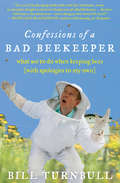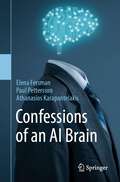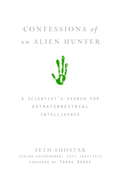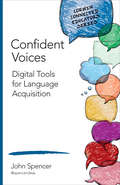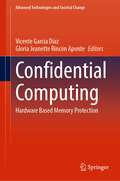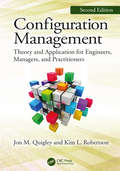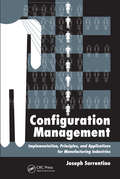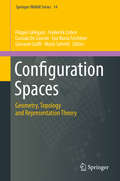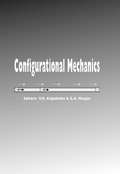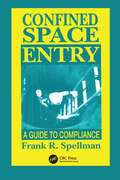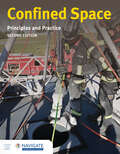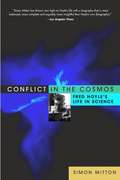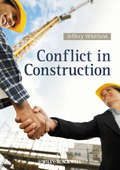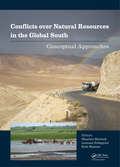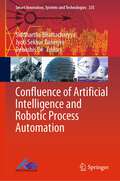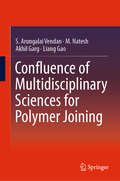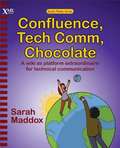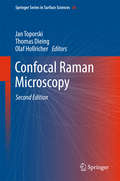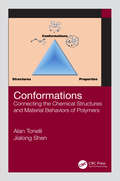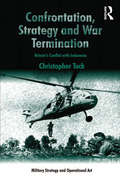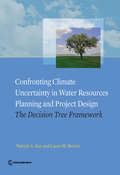- Table View
- List View
Conference Proceedings of the 2024 4th International Joint Conference on Energy, Electrical and Power Engineering: Volume I (Lecture Notes in Electrical Engineering #1408)
by Weimin Wu Xinzhang Wu Kun TanEnergy, Electrical, and Power Engineering are dynamic fields undergoing rapid change and innovation. This volume encompasses cutting-edge research and advances in electrical and power engineering, covering a wide range of topics including power electronics technology, renewable energy generation, intelligent control systems, and more. With contributions from renowned experts and scholars, it provides valuable insights and innovative solutions to address the challenges and opportunities in the ever-evolving energy landscape. This volume serves as a comprehensive resource for staying abreast of the latest trends and act as a catalyst for advancing this dynamic field. Following the success of the CoEEPE 2021, 2022 and 2023, this volume will provide resources for a diverse readership, including professionals, scientists, practitioners, researchers, and graduate students.
Conference Proceedings of the 2024 4th International Joint Conference on Energy, Electrical and Power Engineering: Volume II (Lecture Notes in Electrical Engineering #1403)
by Cungang Hu Wenping Cao Yawei HuEnergy, Electrical, and Power Engineering are dynamic fields undergoing rapid change and innovation. This volume encompasses cutting-edge research and advances in electrical and power engineering, covering a wide range of topics including power electronics technology, renewable energy generation, intelligent control systems, and more. With contributions from renowned experts and scholars, it provides valuable insights and innovative solutions to address the challenges and opportunities in the ever-evolving energy landscape. This volume serves as a comprehensive resource for staying abreast of the latest trends and act as a catalyst for advancing this dynamic field. Following the success of the CoEEPE 2021, 2022 and 2023, this volume will provide resources for a diverse readership, including professionals, scientists, practitioners, researchers, and graduate students.
Conference Proceedings of the Second International Conference on Recent Advances in Bioenergy Research: ICRABR 2016 (Springer Proceedings in Energy)
by Sachin Kumar Y. K. Yadav Rajesh K. SaniThis book discusses latest advances in the area of bioenergy, including algal biomass, biodiesel, bioethanol, biomethanation, pyrolysis, biomass gasification, biomass cook stoves and integrated processes. The volume comprises select proceedings of ICRABR-2016. The contents include cutting-edge research vital to R&D organizations, academics and the industry to promote and document the recent developments in the area of bioenergy for all types of stakeholders. The book highlights the need for biofuels and their market, the barriers and challenges faced by biofuels and bioenergy, and future strategies required to foster new ideas for research, collaboration, and commercialization of bioenergy. It addresses various topics, such as biomass and energy management; thermochemical conversion processes; biochemical conversion processes; catalytic conversion processes; electrochemical processes; waste treatment to harvest energy; and integrated processes. It will prove a valuable resource for students, researchers, professionals and policymakers in the field of biofuels and bioenergy.
Confessions of a Bad Beekeeper: What Not to Do When Keeping Bees (with Apologies to My Own)
by Bill TurnbullThe popular host of BBC Breakfast recounts his many misadventures as a backyard beekeeper—“A truly wonderful read” (Diana Sammataro, PhD, coauthor of The Beekeeper’s Handbook).Bill Turnbull had no intention of becoming a beekeeper. But when he saw an ad for beekeeping classes—after a swarm of bees landed in his suburban backyard—it seemed to be a sign. Despite being stung on the head—twice—at his first hands-on beekeeping class, Turnbull found himself falling in love with the fascinating, infuriating honeybee.As a new beekeeper, Turnbull misplaced essential equipment, got stung more times—and in more places—than he cares to remember, and once even lost some bees up a chimney. But he kept at it, with a ready sense of humor and Zen-like acceptance of every mishap. And somehow, along the way, he learned a great deal about himself and the world around him.Confessions of a Bad Beekeeper chronicles Turnbull’s often hilarious and occasionally triumphant adventures in the curious world of backyard beekeeping. Along the way, he offers plenty of hard-won apiarian wisdom and highlights both the threat to our bee population and what we can do to help these vital little creatures do their wonderful work.
Confessions of an AI Brain
by Paul Pettersson Elena Fersman Athanasios KarapantelakisHave you thought of how it feels to be an AI brain in the world of humans? This book allows such a brain to tell us how it takes on its mission of helping humans to develop a more efficient, sustainable, diverse and inclusive society.This book explains the principles and applications of artificial intelligence for a broad audience. Artificial intelligence, as part of computer science, is often inspired by human intelligence. At the same time, there is still reluctance in the applications and usability of artificial intelligence among citizens. Industries are deploying AI in their products and processes but the level of maturity is varying. The book is written as a first person narrative, from an AI perspective, having the AI brain tell the story.
Confessions of an Alien Hunter
by Seth ShostakAliens are big in America. Whether they've arrived via rocket, flying saucer, or plain old teleportation, they've been invading, infiltrating, or inspiring us for decades, and they've fascinated moviegoers and television watchers for more than fifty years. About half of us believe that aliens really exist, and millions are convinced they've visited Earth.For twenty-five years, SETI has been looking for the proof, and as the program's senior astronomer, Seth Shostak explains in this engrossing book, it's entirely possible that before long conclusive evidence will be found.His informative, entertaining report offers an insider's view of what we might realistically expect to discover light-years away among the stars. Neither humanoids nor monsters, says Shostak; in fact, biological intelligence is probably just a precursor to machine beings, enormously advanced artificial sentients whose capabilities and accomplishments may have developed over billions of years and far exceed our own.As he explores what, if anything, they would tell us and what their existence would portend for humankind and the cosmos, he introduces a colorful cast of characters and provides a vivid, state-of-the-art account of the past, present, and future of our search for extraterrestrial intelligence.
Confident Voices: Digital Tools for Language Acquisition (Corwin Connected Educators Series)
by John T. SpencerEngage your ELL students through technology! When it comes to technology integration, don’t overlook the needs of your ELL students. Introduce project-based learning into your classroom and utilize strategies to engage your ELL students and bridge the growing divide between technology and the ELL students that need it to thrive. Connected Educator John Spencer shows ELL educators how to combine technology with teaching in this easy-to-use guide to blended learning. Get ready to: Blend innovative technology with project-based learning Strengthen your students’ English language skills Engage your students through the intentional integration of digital tools The Corwin Connected Educators series is your key to unlocking the greatest resource available to all educators: other educators. Being a Connected Educator is more than a set of actions: it’s a belief in the potential of technology to fuel lifelong learning."John Spencer is the kind of teacher that I wish my own kids had and that all students deserve. This book shows clearly and practically how technology can be used to give all students greater choice and a more powerful voice. This book inspired me to rethink my own approach and what I′m planning to do in my classroom tomorrow." Philip Cummings, 6th Grade Teacher Presbyterian Day School "Spencer provides a clear framework for teachers to help students improve their language skills. A teacher can pick this book up and be provided with specific ideas and techniques which can be implemented in a classroom immediately." Josh Stumpenhorst, Teacher Lincoln Junior High School Naperville, IL
Confident Voices: Digital Tools for Language Acquisition (Corwin Connected Educators Series)
by John T. SpencerEngage your ELL students through technology! When it comes to technology integration, don’t overlook the needs of your ELL students. Introduce project-based learning into your classroom and utilize strategies to engage your ELL students and bridge the growing divide between technology and the ELL students that need it to thrive. Connected Educator John Spencer shows ELL educators how to combine technology with teaching in this easy-to-use guide to blended learning. Get ready to: Blend innovative technology with project-based learning Strengthen your students’ English language skills Engage your students through the intentional integration of digital tools The Corwin Connected Educators series is your key to unlocking the greatest resource available to all educators: other educators. Being a Connected Educator is more than a set of actions: it’s a belief in the potential of technology to fuel lifelong learning."John Spencer is the kind of teacher that I wish my own kids had and that all students deserve. This book shows clearly and practically how technology can be used to give all students greater choice and a more powerful voice. This book inspired me to rethink my own approach and what I′m planning to do in my classroom tomorrow." Philip Cummings, 6th Grade Teacher Presbyterian Day School "Spencer provides a clear framework for teachers to help students improve their language skills. A teacher can pick this book up and be provided with specific ideas and techniques which can be implemented in a classroom immediately." Josh Stumpenhorst, Teacher Lincoln Junior High School Naperville, IL
Confidential Computing: Hardware Based Memory Protection (Advanced Technologies and Societal Change)
by Vicente Garcia Diaz Gloria Jeanette Rincón AponteThis book highlights the three pillars of data security, viz protecting data at rest, in transit, and in use. Protecting data at rest means using methods such as encryption or tokenization so that even if data is copied from a server or database, a thief cannot access the information. Protecting data in transit means making sure unauthorized parties cannot see information as it moves between servers and applications. There are well-established ways to provide both kinds of protection. Protecting data while in use, though, is especially tough because applications need to have data in the clear—not encrypted or otherwise protected—in order to compute. But that means malware can dump the contents of memory to steal information. It does not really matter if the data was encrypted on a server’s hard drive if it is stolen while exposed in memory. As computing moves to span multiple environments—from on-premise to public cloud to edge—organizations need protection controls that help safeguard sensitive IP and workload data wherever the data resides. Many organizations have declined to migrate some of their most sensitive applications to the cloud because of concerns about potential data exposure. Confidential computing makes it possible for different organizations to combine data sets for analysis without accessing each other’s data.
Configuration Management, Second Edition: Theory and Application for Engineers, Managers, and Practitioners
by Jon M. Quigley Kim L. RobertsonThe book provides a comprehensive approach to configuration management from a variety of product development perspectives, including embedded and IT. It provides authoritative advice on how to extend products for a variety of markets due to configuration options. The book also describes the importance of configuration management to other parts of the organization. It supplies an overview of configuration management and its process elements to provide readers with a contextual understanding of the theory, practice, and application of CM. The book illustrates the interplay of configuration and data management with all enterprise resources during each phase of a product lifecycle.
Configuration Management: Implementation, Principles, and Applications for Manufacturing Industries
by Joseph SorrentinoBest Practices in Configuration Management to Ensure QualityMany organizations are invoking a new kind of management technique - Configuration Management - meant to ensure a product maintains its originally intended design, materials, composition, and processing throughout its entire lifecycle. This method moves away from current supply chain think
Configuration Spaces: Geometry, Topology and Representation Theory (Springer INdAM Series #14)
by Filippo Callegaro Frederick Cohen Corrado De Concini Eva Maria Feichtner Giovanni Gaiffi Mario SalvettiThis book collects the scientific contributions of a group of leading experts who took part in the INdAM Meeting held in Cortona in September 2014. With combinatorial techniques as the central theme, it focuses on recent developments in configuration spaces from various perspectives. It also discusses their applications in areas ranging from representation theory, toric geometry and geometric group theory to applied algebraic topology.
Configurational Mechanics: Proceedings of the Symposium on Configurational Mechanics, Thessaloniki, Greece, 17-22 August 2003
by Gérard A. Maugin Vassilios K. KalpakidesThis book comprises papers that were presented at the Symposium on Configurational Mechanics, during the 5th EUROMECH Soil Mechanics Conference in Thessaloniki in August 2003. Configurational (or material) mechanics -in contrast to Newtonian mechanics in Euclidean space- concerns any sort of change or "motion" in the material configuration. This fr
Confined Space Entry: Guide to Compliance
by Frank R. SpellmanFROM THE PREFACEThis book brings together (in one text) all of the Occupational Safety and Health Administration's regulatory requirements for making safe and proper confined space entries. Because confined space entry is a complicated procedure-and a process that contains inherent risks-those concerned with safety in the work place are constan
Confined Spaces 2E: Principles and Practice
by Jones & Bartlett LearningThe Public Safety Group, a Jones & Bartlett Learning brand, is pleased to present the second edition of Confined Space: Principles and Practice. This edition provides a complete confined space rescue training solution that meets and exceeds the intent of the job performance requirements (JPRs) within Chapter 7: Confined Space Rescue of the 2021 edition of NFPA 1006, Standard for Technical Rescue Personnel Professional Qualifications. First responders learn everything from sizing up and controlling an incident site to effective victim rescue and retrieval-all while keeping themselves, their colleagues, and the public safe. Engaging training components for each chapter include a You are the Rescuer case study, safety tips, skill drills, key terms, a chapter summary, and much more.Now in the second edition:New: Content is new and fully updated, and each knowledge objective and skills objective is based on and mapped to a section of NFPA 1006. New: The book is divided into sections for the three levels of responder training: Awareness (Chapters 1-4), Operations (Chapters 5-9), and Technician (Chapters 10-12). Each contains information specific to its respective level of training and skills. New: "On Scene" sections in each chapter are based on real events and include questions that immediately follow the narrative.New: All photography for Skill Drills is new.New: Review Questions for each chapter help ensure learner success.New: "You Are the Rescuer" features and discussion questions are included at the beginning of each section.New: Photographs and other visuals show up-to-date gear, techniques, and safety precautions.New: Up-to-date content showcases current equipment and best practices.Confined Space: Principles and Practice, Second Edition includes the following features: A single, complete curriculum solution that supports both students and instructorsOne access code that unlocks digital components to complement the print resource Study tools to help students succeed, including lecture outlines and flashcardsAn eBook, Audiobook, and Skill Drill Slides to engage all students and enable learning on the go © 2026 | 500 pages
Conflict In The Cosmos: Fred Hoyle's Life In Science
by Simon MittonWhile other British astronomers were specializing in narrow areas, says Mitton (astronomy, Cambridge U. ), Hoyle claimed the entire celestial realm--the universe and all its contents--as his field, and proceeded to transform the discipline during the third quarter of the 20th century. Much of the insight in the biography is gleaned from Hoyle's asso
Conflict in Construction
by Jeffery WhitfieldConstruction projects are beset with disputes. In 1960 around 250 writs were issued relating to construction disputes. Within 30 years this number increased five-fold, and in the 20 years since then the number of disputes has not fallen. Some disputes are significant, others are quite minor, but most could probably be avoided. Disputes originate in disagreements or conflict between individuals, which if addressed early, can prevent escalation into situations that are difficult, expensive and time consuming to resolve. Conflicts in Construction deals with all types of conflict but concentrates on the conflicts that lead to disputes in construction projects. The book shows the reader how to avoid, manage and resolve conflicts before they become serious disputes. The first edition of Conflicts in Construction was read widely and saved many individuals and companies from falling into intractable disputes. The second edition, fully updated, forms the base content for the Hill/ Knowles seminar series on conflicts, delivered around the globe by the author, and will be an important read for everyone employed in the construction industry.
Conflicts over Natural Resources in the Global South: Conceptual Approaches
by Lorenzo Pellegrini Maarten Bavinck Erik MostertInhabitants of poor, rural areas in the Global South heavily depend on natural resources in their immediate vicinity. Conflicts over and exploitation of these resources � whether it is water, fish, wood fuel, minerals, or land � severely affect their livelihoods. The contributors to this volume leave behind the polarised debate, previously surround
Confluence of Artificial Intelligence and Robotic Process Automation (Smart Innovation, Systems and Technologies #335)
by Debashis De Siddhartha Bhattacharyya Jyoti Sekhar BanerjeeThis book provides a detailed insight into Robotic Process Automation (RPA) technologies linked with AI that will help organizations implement Industry 4.0 procedures. RPA tools enhance their functionality by incorporating AI objectives, such as use of artificial neural network algorithms, text mining techniques, and natural language processing techniques for information extraction and the subsequent process of optimization and forecasting scenarios for the purpose of improving an organization's operational and business processes. The target readers of this book are researchers, professors, graduate students, scientists, policymakers, professionals, and developers working in the IT and ITeS sectors, i.e. people who are working on emerging technologies. This book also provides insights and decision support tools necessary for executives concerned with different industrial and organizational automation-centric jobs, knowledge dissemination, information, and policy development for automation in different educational, government, and non-government organizations. This book is of special interest to college and university educators who teach AI, machine learning, blockchain, business intelligence, cognitive intelligence, and brain intelligence courses in different capacities.
Confluence of Multidisciplinary Sciences for Polymer Joining
by S. Arungalai Vendan Liang Gao Akhil Garg M. NateshThis book offers a systematic overview of polymer joining and highlights the experimental and numerical work currently being pursued to devise possible strategies to overcome the technical issues. It also covers the fundamentals of polymers, the corresponding joining processes and related technologies. A chapter on the extrapolation of finite element analysis (FEA) for forecasting the deformation and temperature distribution during polymer joining is also included. Given its breadth of coverage, the book will be of great interest to researchers, engineers and practitioners whose work involves polymers.
Confluence, Tech Comm, Chocolate
by Sarah MaddoxWeb and Tech Comm guru Sarah Maddox takes you inside the Confluence wiki for an in-depth guide to developing and publishing technical documentation on a wiki. She looks at life on a wiki from the points of view of both technical writers and readers. Confluence, Tech Comm, Chocolate shows you how to make your wiki fly.While it focuses on Confluence, the concepts and strategies can be used with any wiki. The basic message is that technical documentation becomes true communication when you add the social and collaborative tools that a wiki provides.Inside the Book Introduction Developing Technical Documentation on a Wiki Life on a Wiki Giving Your Wiki Wings Glossary and Index
Confocal Raman Microscopy (Springer Series In Optical Sciences #158)
by Jan Toporski Thomas Dieing Olaf HollricherThis second edition provides a cutting-edge overview of physical, technical and scientific aspects related to the widely used analytical method of confocal Raman microscopy. The book includes expanded background information and adds insights into how confocal Raman microscopy, especially 3D Raman imaging, can be integrated with other methods to produce a variety of correlative microscopy combinations. The benefits are then demonstrated and supported by numerous examples from the fields of materials science, 2D materials, the life sciences, pharmaceutical research and development, as well as the geosciences.
Conformations: Connecting the Chemical Structures and Material Behaviors of Polymers
by Alan E. Tonelli Jialong ShenAmong the materials found in Nature’s many diverse living organisms or produced by human industry, those made from polymers are dominant. In Nature, they are not only dominant, but they are, as well, uniquely necessary to life. Conformations: Connecting the Chemical Structures and Material Behaviors of Polymers explores how the detailed chemical structures of polymers can be characterized, how their microstructural-dependent conformational preferences can be evaluated, and how these conformational preferences can be connected to the behaviors and properties of their materials. The authors examine the connections between the microstructures of polymers and the rich variety of physical properties they evidence. Detailed polymer architectures, including the molecular bonding and geometries of backbone and side-chain groups, monomer stereo- and regiosequences, comonomer sequences, and branching, are explicitly considered in the analysis of the conformational characteristics of polymers. This valuable reference provides practicing materials engineers as well as polymer and materials science students a means of understanding the differences in behaviors and properties of materials made from chemically distinct polymers. This knowledge can assist the reader design polymers with chemical structures that lead to their desired material behaviors and properties.
Confrontation, Strategy and War Termination: Britain's Conflict with Indonesia (Military Strategy and Operational Art)
by Christopher TuckAt the heart of this book is the problem of war termination. Britain won an almost unbroken string of tactical military victories during an undeclared war against the Republic of Indonesia in the 1960s, yet it proved difficult to translate this into strategic success. Using conflict termination theories, this book argues that British strategy during Confrontation was both exemplary and flawed, both of which need not be mutually exclusive. The British experience in Indonesia represents an illuminating case study of the difficulties associated with strategy and the successful termination of conflicts. The value of this book lies in two areas: as a contribution to the literature on British counter-insurgency operations and as a contribution to the debates on the problems of war termination in the context of strategic thought.
Confronting Climate Uncertainty in Water Resources Planning and Project Design
by Casey M. Brown Patrick A. RayConfronting Climate Uncertainty in Water Resources Planning and Project Design describes an approach to facing two fundamental and unavoidable issues brought about by climate change uncertainty in water resources planning and project design. The first is a risk assessment problem. The second relates to risk management. This book provides background on the risks relevant in water systems planning, the different approaches to scenario definition in water system planning, and an introduction to the decision-scaling methodology upon which the decision tree is based. The decision tree is described as a scientifically defensible, repeatable, direct and clear method for demonstrating the robustness of a project to climate change. While applicable to all water resources projects, it allocates effort to projects in a way that is consistent with their potential sensitivity to climate risk. The process was designed to be hierarchical, with different stages or phases of analysis triggered based on the findings of the previous phase. An application example is provided followed by a descriptions of some of the tools available for decision making under uncertainty and methods available for climate risk management. The tool was designed for the World Bank but can be applicable in other scenarios where similar challenges arise.
